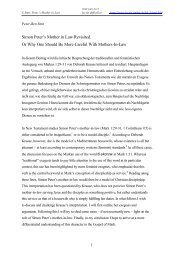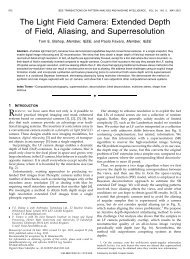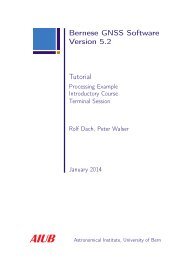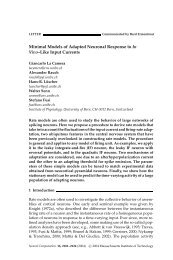Deploying Real-Life WSN Applications: Challenges ... - IAM - CDS
Deploying Real-Life WSN Applications: Challenges ... - IAM - CDS
Deploying Real-Life WSN Applications: Challenges ... - IAM - CDS
Create successful ePaper yourself
Turn your PDF publications into a flip-book with our unique Google optimized e-Paper software.
6 International Journal of Distributed Sensor Networks<br />
INs broadcasting<br />
Data transmission<br />
CH/SCH<br />
Next<br />
IDs<br />
Awake<br />
Data<br />
SUC<br />
RCV<br />
Awake<br />
Asleep<br />
IN1<br />
INk<br />
Next<br />
Data SUC Data SUC<br />
IDs<br />
RCV<br />
RCV<br />
Awake<br />
Awake<br />
··· ···<br />
Awake<br />
Next<br />
IDs<br />
Asleep<br />
Data<br />
Data<br />
RCV SUC<br />
Awake<br />
SUC<br />
RCV<br />
Asleep<br />
BN<br />
Awake<br />
Asleep<br />
Data<br />
RCV<br />
SUC Data<br />
Awake<br />
Node<br />
Awake<br />
Asleep<br />
Figure 4: Timeline for each category during data propagation from CHs to BS.<br />
next hop nodes’ ID, but also includes hop count from CH<br />
to BS along each next hop node. The nodes which receive<br />
NEXT IDs message from CHs/SCHs will mark themselves as<br />
IN1 select their next hop nodes, and rebroadcast NEXT IDs<br />
messages. NEXT IDS messages recurrently broadcast until<br />
they are received by branch nodes. By this way, sensor nodes<br />
in <strong>WSN</strong>s can be distinguished between intermedium nodes<br />
and none-intermedium nodes.<br />
In the data transmission from CHs to BS, only CHs/<br />
SCHs, INs, and BNs keep awake and take part in the data<br />
transmission, whereas other nodes turn into sleep until<br />
the process ends. As shown in Figure 4, after every data<br />
transmission, the sender node will wait for the SUC message<br />
from the recipient. If the SUC message is received, the sender<br />
will turn into sleep until the end of data transmission;<br />
otherwise, if the sender cannot receive the SUC message in<br />
a limited period of time, the sender will resend the data to<br />
another next hop node and the data transmission process<br />
will repeat. Furthermore, in last INs broadcasting process,<br />
each IN knows the hop count of the path it resides, so it can<br />
estimate the waiting time T INi according to (3):<br />
T INi = k [( H path − H INi<br />
)<br />
× ΔT ] . (3)<br />
In (3), H path is the whole hop count of the path, whereas<br />
H INi is the hop count from INi to BS. ΔT is the approximate<br />
time for data transmission between two one-hop nodes,<br />
which includes the time for data transmission and receiving,<br />
plus the time for SUC message transmission and receiving.<br />
Coefficient k is larger than 1, which accounts for delay of data<br />
transmission. During period of T INi , INs keep asleep and do<br />
not wake up until the end of T INi . Using this flexible MAC<br />
protocol, all nodes turn into sleep in their unnecessary time,<br />
so energy consumption in this phase could be decreased<br />
greatly.<br />
There are several disjoint paths for data delivery from<br />
CHs to BS. As illustrated in Figure 3, the solid arrow path is<br />
the primary path from CH to BS, whereas the dashed arrow<br />
paths are alternative paths as the backup of primary path.<br />
Ultimately, the sensed data and the parameters of the<br />
network (sum of nodes N, whole residual energy E to ) should<br />
be retrieved by the BS. Then the BS initiates another round.<br />
3.3. Node Classification. Based on the functionality in <strong>WSN</strong>,<br />
we defined five classifications for sensor nodes. It is remarkable<br />
that some category may exist only in a specific phase not<br />
the entire process.<br />
3.3.1. Branch Node (BN). The definition of the BN is the<br />
one-hop neighbors of the base station. According to the<br />
branch aware flooding algorithm [7], each BN represents one<br />
branch. As shown in Figure 2, nodes A, B, C, and D are<br />
BNs. In phase 1, upon receiving the first message, the node<br />
marks the sender node as its parent and the path in which<br />
parent node resides is regarded the primary path. If a node<br />
receives an initial broadcasting message with different BN<br />
value from the value of its parent node, it can be regarded<br />
as the discovery of an alternative path.<br />
According to the simulation result in [7], the nearer to<br />
the BS, the node has more burdens on data transmission.<br />
The BN acts a critical role in the network, because once it is<br />
exhausted the whole branch is separated and the downstream<br />
paths are correspondingly failed. In order to conserve energy,<br />
in our proposed mechanism the BN does not join the cluster<br />
formation and data sense. It only acts as a router in the<br />
network. Furthermore, BNs keep asleep in phase 2, by this<br />
way BNs conserve much energy. If its energy is below a<br />
limitation value, it should announce that it abandons the role<br />
of branch node and transforms to a normal node.<br />
In phase 1, if node i received initial broadcasting message<br />
directly from BS, it will decide whether it should be a branch<br />
node according to its residual energy:<br />
E re ≥ E B = k(M ∗ (E TX + E RC )). (4)

















